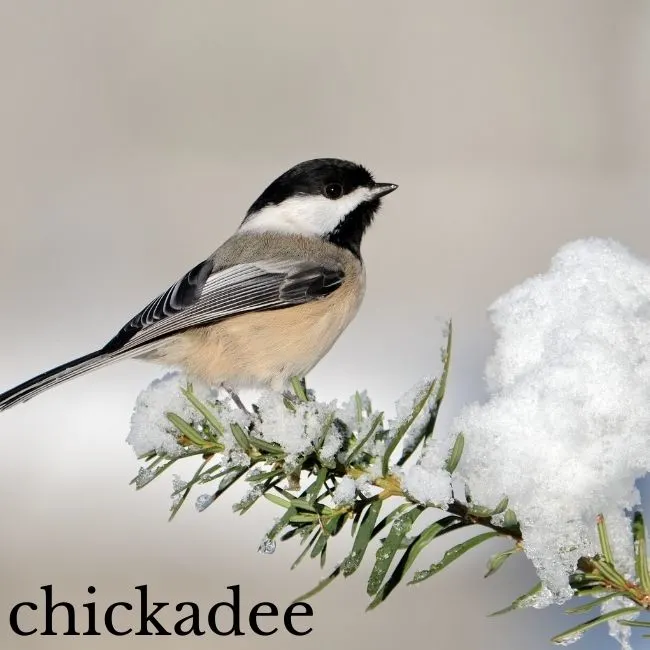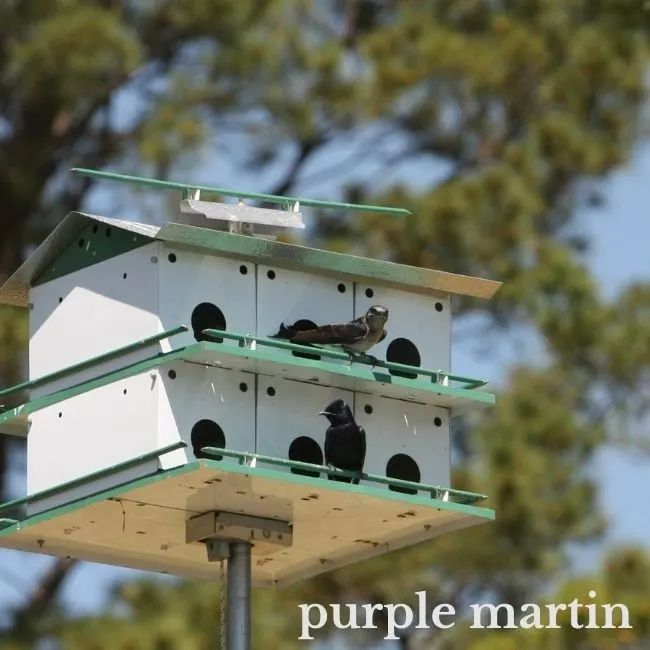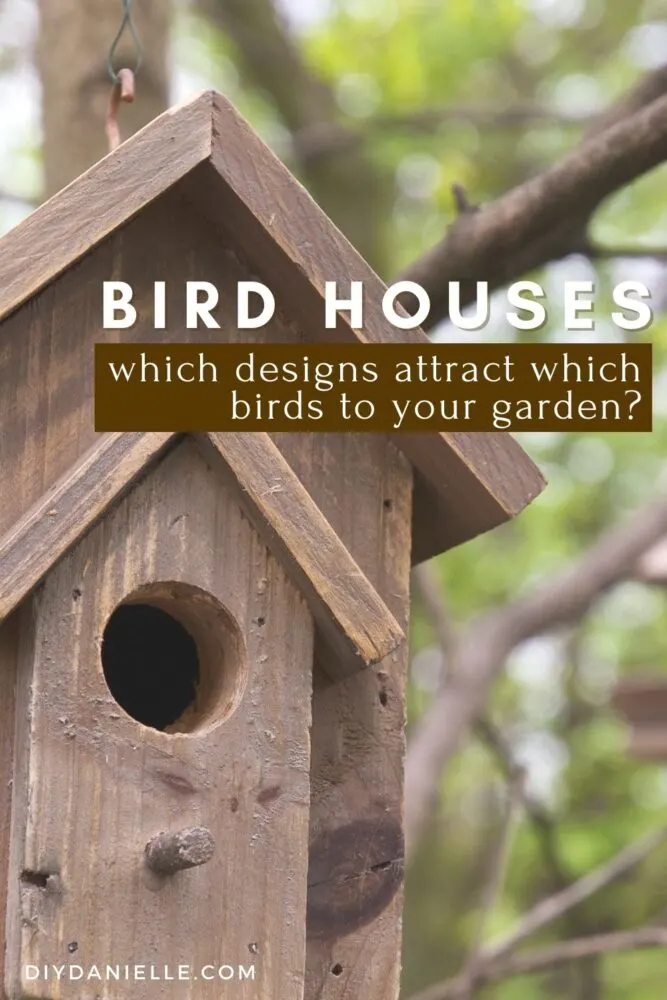Tips of buying or building the right birdhouse to attract birds to your garden and home. Not all bird houses are right for every bird. Attract beneficial birds to your garden by making a bird house that’s just right for them.
While birds can be considered a garden pest, they can also be beneficial to have in your garden. While they may eat berries and other items you grow, they can also eat bugs that you don’t want in your garden. I always try to plant enough to share with the wildlife, and every Fall I sit in my overgrown garden and watch the birds harvest sunflower seeds directly from the tall flowers. It’s one of the joys of having a big enough garden to share. Even though we have plenty of birds already and they nest in surrounding trees, this year I want to add some birdhouses to my garden.
Attracting birds to your garden is a lot more than just setting up a birdhouse, however. For starters, different birds prefer to live in different type of spaces, so the type of birds you attract depend on the type of birdhouse you use. You can tailor your birdhouse selection to the specific birds you’d like to see in your garden.
Here’s a guide on what to build or buy for different types of common birds.
This post may contain affiliate links which may earn me commissions should you click through them and take certain actions. As an affiliate for Amazon, Cricut, xTool, Home Depot, and other sites, I earn from qualifying purchases. Please DIY carefully. View my full legal disclosures here.
Please read the whole post so you don’t miss any important information!
Things to Consider when Choosing a Birdhouse
Size of the Box
A smaller house might make the birds cramped in while making them too large might fail to keep the baby birds warm. The bigger the bird, the larger the house.
Entryway
Some birds prefer houses with open sides while others prefer a certain shape for the entrance. Knowing the difference helps you attract your choice of birds.
Size of the Entrance Hole
The correct hole size is big enough for your desired birds to use but small enough to keep predators away.
Color
Most birds prefer earth-colored houses except purple martins that prefer white. Bright colors might also be helpful to attract specific types of birds.
Material
Wood is typically the best choice of material but depending on the type of bird, aluminum, dried gourds, or other materials may also be used.
Ventilation and Drainage
Proper ventilation and drainage holes in the floors are necessary regardless of the type of bird you want to attract.
Type of Birdhouses for Different Types of Birds
Bluebirds

Bluebirds prefer to eat insects and insect larvae, but also enjoy some types of berries when the insect population declines in cold weather.
Size
Bluebirds need small houses, ideally 5-inch x 5-inch, with one room with large sloping roofs. Each house should be about 50 – 75 yards away from another.
Entrance Hole
These birds need small, east-facing, entrance holes of 1.5-inch diameter, with perches in front. Making two holes may provide bluebirds with a better defense against predators.
Location
These birdhouses should be placed 5 – 8 feet above the ground, in open areas with available food to feed the baby birds.
Protection
Cone-shaped predator baffles may be used for protection from intruder birds and predators.

Robins
Robins predominately eat insects and worms, but may also eat small reptiles and amphibians, including snakes. They also will eat berries.
Robins do not need birdhouses. To attract Robins to your garden, use nesting shelves or platforms that do not have a roof, placed about 5 – 25 feet above the ground. If there’s a roof it should be slanted to drip off rainwater.
House Wrens

House wrens love to find and eat insects in your garden.
Size
A house that’s 4-inch x 6-inch or 5-inch x 5-inch and about 8-inches in height is preferred for wrens.
Entrance Hole
The diameter of the entrance hole should not be bigger than 1.25 inches.
Location
Houses for wrens should be placed near woody vegetation, 5 – 10 feet above the ground, and away from other birdhouses.
Chickadees

Chickadees are one of my favorite birds. My paternal grandmother loved to point out different birds and she would coo, “chickadeedeedeedee” at the birds we saw.
Size
Chickadees need the same size of house as house wrens.
Entrance Hole
The hole should be about 1.125-inches in diameter and 6 inches above the base of the birdhouse.
Location
Chickadees like their houses to be in covered areas like in a stand of shrubs and 4 – 8 feet above the ground.
Purple Martins
Size

Purple Martins prefer to stay in colonies, so apartment-style s with multiple rooms or multiple nesting gourds should be used. These could also be on multiple levels.
Entrance Hole
Since they like to live together, having multiple entrance holes could be good. The holes should have diameters of about 2.125-inches, and the bottom of the holes should be on the same level as the floor of each room.
Location
These should be placed in open lawns of fields, away from obstacles, and 10 – 18 feet above the ground.
Color
Purple Martins prefer houses painted white on the outside.
Materials
Wood and aluminum houses could be used but gourds have shown larger reproduction success for Purple Martins.
Owls
Owls may or may not be something you want to attract to your garden. Many are carnivores, and will eat small birds, mice, rabbits, and other small mammals. This works well if you have a rabbit problem in your garden, but not if you raise chickens.
Owls generally prefer abandoned nests that have previously been inhabited by other birds.
Size
Owls need large houses of around 10-inch x 10-inch base, about 24-inches in height.
Entrance Hole
The entrance holes should be about 3 to 6 inches in diameter depending on the size of the type of owl.
Location
Birdhouses for owls should be located in the woods or within mature trees, about 15 feet above the ground.
Woodpeckers
Add wood shavings or sawdust inside the birdhouse, up to a couple of inches, for woodpeckers to nest.
Entrance Hole
According to the species of woodpecker, the hole size varies from 1.25-inches to 2.5-inches.
Location
Place these houses 8 – 12 feet above ground in direct sunlight.
Doves
Doves prefer platforms with open sides, placed 5 – 25 feet above the ground. They are also attracted to platforms in dull colors like gray and brown.
Sparrows
Sparrows accept most birdhouses and typically prefer spaces abundant in trees, leaves, and shrubs.
If you want to dedicate a specific house for Sparrows make sure to place them 5 – 15 feet above the ground. Make the entrance holes 1.25 to 2 inches in diameter and avoid adding perches in front.
Why do you want to attract different birds to your garden?
Pest and weed control
Birds eat several different insects as a part of the ecosystem and keep the bugs in control in your garden. Some birds also eat weed seeds, which control the weeds and help the landscaping.
Pollination
Birds that drink nectar from the flowers help in pollination that’ll give rise to flowers and in turn attract more birds to the garden.
Education
Having lots of birds in your garden allows you to learn about the variety of birds, their needs, behaviors, and environments.
Aesthetics and Relaxation
Having different types of birds in your garden will help increase the audiovisual quality of your garden and make it a more soothing place to be in. Spending time in your garden can now become a stress relief activity.
Conservation
Inviting the birds to your garden creates new habitats for them and helps in the conservation of birds and related aspects of their ecosystem.
Types of Birdhouses on Amazon
Types of birdhouses that you can buy on Amazon and which birds they suit best.
Purple martins prefer to live in colonies so this bird house is perfect for the whole group.
This is a great design for attracting bluebirds to your garden.
This bird house is perfect for smaller birds like wrens or chickadees.
Attract owls with this cedar nesting box.
Bats are excellent bug eaters and love the right bat house, even though they aren't technically birds.
Please share and pin this post! If you make this project, share it in our Stuff Mama Makes Facebook Group. We have regular giveaways for gift cards to craft stores. You can also tag me on Instagram @doityourselfdanielle; I love seeing everything you make!


References





